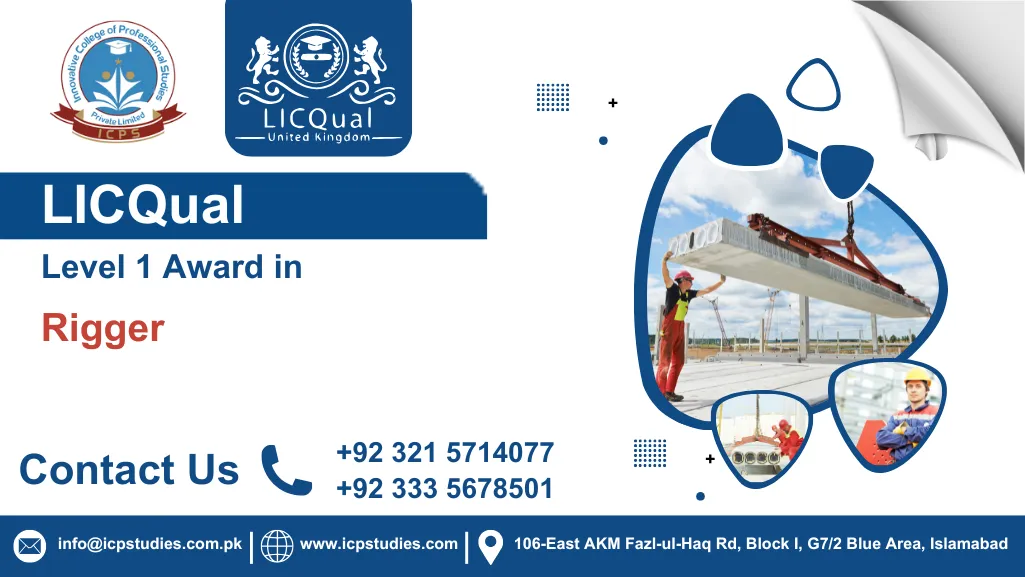The LICQual Level 1 Award in Rigger is an entry‑level qualification designed to introduce learners to the fundamental skills and knowledge required for safe rigging operations. Rigging plays a critical role in industries such as construction, oil and gas, shipping, and manufacturing, where the movement and securing of heavy loads must be carried out with precision and safety. This course provides a structured foundation for individuals who are new to the field, ensuring they understand the basic principles of rigging, the correct use of equipment, and the importance of adhering to safety standards.
Throughout the training, learners will explore the essential tools, techniques, and practices used in rigging operations. The course emphasizes the identification and proper handling of rigging equipment, the safe application of knots, hitches, and lifting gear, as well as the importance of teamwork and communication during lifting tasks. By combining theoretical knowledge with practical awareness, participants will gain the confidence to support rigging activities under supervision while developing a strong safety‑first mindset.
Completing LICQual Level 1 Award in Rigger demonstrates a learner’s readiness to begin a career in rigging or related industries. It also highlights their commitment to workplace safety and professional development. The LICQual Level 1 Award in Rigger serves as a stepping stone for further progression into advanced rigging qualifications, enabling learners to build their competence and pursue specialized roles in lifting and rigging operations.
All About LICQual Level 1 Award in Rigger
Course Overview
The LICQual Level 1 Award in Rigger is an introductory qualification designed to provide learners with the fundamental knowledge and awareness required for safe rigging operations. Rigging is a critical skill across industries such as construction, oil and gas, shipping, and manufacturing, where loads must be lifted, moved, and secured with precision and safety. This award ensures that learners gain a strong foundation in rigging practices, equipment handling, and workplace safety standards, preparing them for entry‑level roles in the field.
The qualification is structured into 6 total units, each focusing on a key aspect of rigging operations. Learners will explore topics such as the identification and use of rigging equipment, safe lifting techniques, hazard awareness, teamwork, and communication during lifting tasks. These units are designed to build knowledge progressively, ensuring participants develop both theoretical understanding and practical awareness of rigging responsibilities.
With 6 total credits and a Guided Learning Hours (GLH) of 12, the course offers a concise yet comprehensive learning experience. The manageable duration makes it accessible for new entrants while still providing sufficient depth to cover essential rigging skills. Learners will benefit from structured training that emphasizes safety, compliance, and practical application, making the qualification suitable for those starting their careers in rigging or related industries.
The qualification is formally recognized under Qualification # LICQ2200068, ensuring credibility and alignment with industry standards. Successful completion of this award demonstrates a learner’s commitment to workplace safety and professional development. It also serves as a stepping stone for progression into higher‑level rigging or lifting operations qualifications, enhancing employability and competence in industries where rigging plays a vital role.
Entry Requirements for the QualCert Level 3 Diploma in ISO Management System Audit Techniques and Best Practices:
To enroll in the LICQual Level 1 Award in Rigger, the following requirements apply:
Age Requirement: Learners must be at least 16 years old at the time of enrollment. This ensures participants have the maturity and responsibility needed to engage with workplace safety training.
Educational Requirement: No formal academic qualifications are required; however, a basic understanding of workplace health and safety principles is recommended to support effective learning.
Language Proficiency: Learners should have a good command of English, both written and spoken, to follow course materials, instructions, and assessments successfully. This ensures they can understand technical terminology and communicate effectively in workplace contexts.
Work Experience: Prior experience in rigging or lifting operations is helpful but not mandatory. The course is designed for newcomers entering the industry as well as existing staff seeking to strengthen their foundational knowledge.
The LICQual Level 1 Award in Rigger is accessible to a wide range of learners, making it an excellent starting point for those beginning their careers in rigging or related industries. By meeting these entry requirements, participants can confidently engage with the training and build the essential skills needed to contribute to safe and effective rigging operations.
The ideal learner for the LICQual Level 1 Award in Rigger is someone who is motivated to begin a career in rigging, eager to learn the fundamentals of safe lifting and load handling, and committed to building a strong foundation in workplace safety. This qualification is designed for individuals who may be new to the industry but are ready to develop the essential skills and awareness required to support rigging operations effectively.
Age & Maturity
- Minimum age of 16 years
- Demonstrates responsibility and willingness to follow safety rules
- Shows maturity in handling practical and theoretical learning
- Capable of working under supervision in a team environment
- Ready to apply knowledge in real workplace scenarios
Educational Background
- No formal academic qualifications required
- Basic understanding of workplace safety is beneficial
- Ability to grasp simple technical concepts related to rigging
- Interest in learning about tools, equipment, and lifting practices
- Open to continuous skill development and training
Language Proficiency
- Good command of English (written and spoken)
- Able to understand course materials and instructions clearly
- Comfortable with technical terms used in rigging operations
- Capable of completing assessments effectively
- Willing to improve communication skills in a professional context
Work Experience
- No prior experience required, making it accessible to beginners
- Suitable for those entering industries such as construction, oil and gas, or shipping
- Helpful for workers seeking to formalize basic rigging knowledge
- Beneficial for assistants or trainees supporting lifting operations
- Provides a pathway for progression into advanced Rigging Course
Professional Attitude
- Committed to maintaining high safety standards
- Willing to take responsibility for safe practices under supervision
- Demonstrates teamwork and cooperation in workplace settings
- Interested in improving employability and career prospects
- Values compliance with industry regulations and best practices
Learning Motivation
- Keen to gain a recognized entry‑level certification
- Motivated to build confidence in rigging operations
- Interested in reducing risks and promoting safety in the workplace
- Seeks to contribute positively to organizational safety culture
- Aspires to progress into higher‑level rigging or lifting certifications
The ideal learner for the LICQual Level 1 Award in Rigger is someone who values safety, teamwork, and professional growth. Whether starting a new career or strengthening existing skills, this qualification provides the foundation needed to perform rigging tasks responsibly and confidently, paving the way for future advancement in the lifting and rigging industry.
Study Units
- Introduction to Rigging
- Basic Rigging Equipment
- Basic Lifting Techniques
- Health & Safety in Rigging
- Communication and Signaling
- Rigging Operations in the Field
Learning Outcomes
By the end of the LICQual Level 1 Award in Rigger, learners will have developed the essential knowledge, skills, and awareness required to carry out basic rigging operations safely and effectively. The course outcomes are designed to ensure participants understand the principles of rigging, the correct use of equipment, and the importance of safety and communication in workplace environments.
1. Introduction to Rigging
- Explain the role and importance of rigging across different industries.
- Identify various rigging tasks and operations commonly performed in the workplace.
- Recognize and correctly use key rigging terminology and principles.
- Demonstrate awareness of the skills required for safe and effective rigging practices.
- Understand how rigging supports wider lifting and operational activities.
2. Basic Rigging Equipment
- Identify and describe common rigging equipment such as slings, hooks, shackles, and pulleys.
- Explain the function and purpose of each piece of rigging equipment.
- Demonstrate the ability to inspect and maintain basic rigging tools to ensure safety.
- Select appropriate rigging equipment based on specific lifting tasks.
- Recognize the limitations and safe usage requirements of rigging tools.
3. Basic Lifting Techniques
- Demonstrate proper techniques for lifting and moving loads safely.
- Understand the principles of load balancing, weight distribution, and securing loads.
- Apply correct lifting methods to minimize risks of injury and equipment damage.
- Recognize the importance of maintaining control and stability during lifting operations.
- Show awareness of safe working loads and factors affecting lifting safety.
4. Health & Safety in Rigging
- Understand key health and safety regulations and guidelines for rigging operations.
- Identify potential hazards in rigging environments and apply measures to mitigate risks.
- Demonstrate correct use of personal protective equipment (PPE) during rigging tasks.
- Conduct risk assessments before, during, and after rigging operations.
- Implement safety protocols to ensure compliance and accident prevention.
5. Communication and Signaling
- Explain the importance of clear communication and signaling in rigging operations.
- Demonstrate the use of standard hand signals, verbal instructions, and radio communication.
- Apply correct communication procedures to ensure safe and efficient lifting tasks.
- Recognize how effective communication prevents accidents and supports teamwork.
- Coordinate with team members to maintain smooth and safe rigging operations.
6. Rigging Operations in the Field
- Apply knowledge and skills to perform basic rigging operations in real-world environments.
- Assess site conditions and select appropriate rigging methods for specific tasks.
- Work effectively as part of a rigging team, following safety procedures and protocols.
- Adapt rigging techniques to address challenges posed by environmental factors.
- Demonstrate practical competence in supporting safe and efficient lifting operations.
By completing the LICQual Level 1 Award in Rigger, learners will be equipped with the foundational skills and awareness necessary to contribute to safe rigging operations. This qualification prepares individuals to work confidently under supervision, supports career entry into industries where rigging is essential, and provides a pathway for progression into advanced rigging and lifting certifications.
FAQs of LICQual Level 1 Award in Rigger

